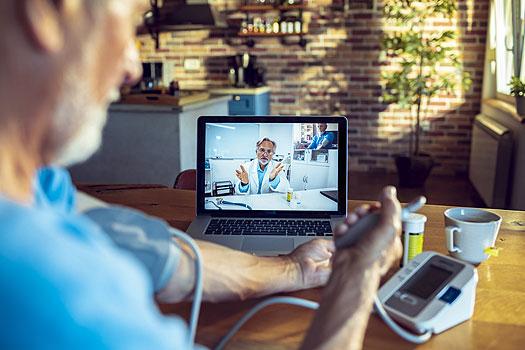Getting the Care You Need via Telemedicine

Keeping on top of your healthcare needs is now more important than ever, but due to the COVID-19 virus, you may be asked by your healthcare system or local physician’s office to avoid in-person visits. Avoiding in-person visits helps control the spread of the disease and ensures that the most critically ill receive frontline care. But just because you may not be able to see your healthcare provider in person does not mean that you should not seek out medical care.
Telemedicine is a new reality for all of us. To make it easier to connect with your healthcare team, the federal government has temporarily expanded telemedicine services for Medicare beneficiaries to cover virtual visits. Virtual visits currently include various modes of interaction with your healthcare team including video chats, phone calls, and e-mail.
The National Council on Aging (NCOA) has put together four key tips to help make your telemedicine visit as beneficial as possible:
Prepare for the Visit
- Write down a list of your symptoms and concerns; be specific.
- Practice what you want to say. That way, you won’t leave anything out.
- Write down a list of all your medications (prescription and nonprescription).
- Check your technology. (If you do not have a computer, tablet, or smartphone, ask a family member for help.)
Find a Quiet Space
- Turn off background noise such as TVs, radios, and smart speakers.
- Ask others in your home to keep the noise level down.
- Allow yourself 10-15 minutes before the video/phone call to collect your thoughts.
- For privacy, consider using headphones during the call.
Tell Your Doctor Everything
- Summarize your condition, list all symptoms, and explain your concerns.
- Share any changes in your medical history and any major life changes.
- Provide any vital signs that you can, such as blood pressure, pulse, and temperature.
Agree on a Treatment Plan
- After your doctor tells you something, repeat it back in your own words.
- Take notes and ask questions such as: What are the risks/benefits of treatment? Are there other ways to treat this? Will insurance pay? Will I need medication?
- Agree on the treatment plan and any additional tests/medications.
- Ask your doctor for resources and about follow-up visits.
- As with any physician visit, it’s ideal if you can have a friend or family member by your side. That person can be responsible for taking notes so that you can focus fully on your conversation with your doctor.
Note: As of March 30, the federal government also is including e-visits (an e-mail exchange via a secure online patient portal) and telephone calls as part of telemedicine.
Source: Susan Stiles, Senior Director of Product Development and Strategy for the National Council on Aging (NCOA), a respected national leader and trusted partner to help people aged 60+ meet the challenges of aging. Their mission is to improve the lives of millions of older adults, especially those who are struggling. Through innovative community programs and services, online help, and advocacy, NCOA is partnering with nonprofit organizations, government, and business to improve the health and economic security of 10 million older adults by 2030.
![Grace Barker Health [logo]](https://www.gracebarkerhealth.com/wp-content/themes/gracebarker-2017/images/logo.png)




